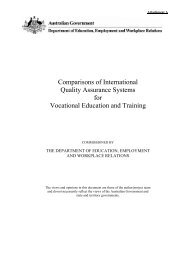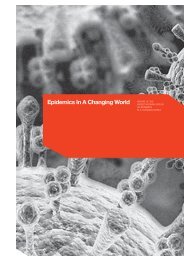First Language (Dinka) Literacy as a Foundation for English ...
First Language (Dinka) Literacy as a Foundation for English ...
First Language (Dinka) Literacy as a Foundation for English ...
Create successful ePaper yourself
Turn your PDF publications into a flip-book with our unique Google optimized e-Paper software.
Section 1: Project Report<br />
Implications & Recommendations<br />
<strong>First</strong> language literacy<br />
While this project had many positive outcomes, the relationship between the <strong>Dinka</strong><br />
literacy training received and <strong>English</strong> literacy learning w<strong>as</strong> very complex and we were not<br />
able to me<strong>as</strong>ure with any certainty the impact that one had upon the other. The <strong>Dinka</strong><br />
cl<strong>as</strong>ses certainly established a strong foundation <strong>for</strong> learning <strong>English</strong> literacy, particularly<br />
<strong>as</strong> the learners were actively engaged in a supportive, <strong>for</strong>mal cl<strong>as</strong>sroom environment<br />
where high value w<strong>as</strong> placed on the written word. While the students varied in their ability<br />
to read <strong>Dinka</strong>, all gained some understanding of the sound-symbol relationships required<br />
to read and this certainly <strong>as</strong>sisted their <strong>English</strong> literacy acquisition. However the limited<br />
timeframe, coupled with the difference in interpretations of literacy, effective teaching<br />
approaches and course content between ACL and the DLA meant that the impact of the<br />
L1 cl<strong>as</strong>ses on the <strong>English</strong> literacy acquisition w<strong>as</strong> difficult to <strong>as</strong>certain. Nevertheless,<br />
further investigation into a first language literacy approach <strong>for</strong> other cl<strong>as</strong>ses would be<br />
valuable.<br />
Recommendation 1: That the level of funding provided by the various State Departments<br />
of Education or other bodies to provide <strong>as</strong>sistance to voluntarily run community (first<br />
language) language schools be reviewed to ensure that the necessary professional<br />
development support and overall sector development occurs, in line with the expansion of<br />
rare languages particularly from the African continent, in the Australian community.<br />
Further, that any such professional development h<strong>as</strong> a focus on b<strong>as</strong>ic modern teaching<br />
practice and methodology <strong>for</strong> literacy acquisition, be it in the first language or <strong>English</strong>,<br />
with considerations given to the pre-existing cultural context of being a “teacher”.<br />
Bilingual teaching<br />
A key factor in the success of the <strong>English</strong> course w<strong>as</strong> the bilingual support provided by<br />
the <strong>Dinka</strong> teachers.<br />
Much more than straight interpreting, bilingual support facilitated the development of<br />
difficult concepts and independent learning strategies that is otherwise left to chance (and<br />
generally does not occur). For example, the bilingual teachers helped with concepts of<br />
time telling, in<strong>for</strong>mation about reading strategies, and explanation of the purpose and<br />
method of certain learning activities. Addressing these issues explicitly in their first<br />
language allowed the cl<strong>as</strong>s to deal with them efficiently and effectively.<br />
The bilingual teachers also allowed <strong>for</strong> genuine and ongoing consultation, feedback and<br />
negotiation between the <strong>English</strong> teacher and the learners. This ensured that the learners<br />
had a strong sense of ownership and involvement in the cl<strong>as</strong>s, which resulted in high<br />
levels of motivation.<br />
Recommendation 2: As much <strong>as</strong> possible, provide bilingual support <strong>for</strong> early literacy<br />
learners. Ensure the bilingual <strong>as</strong>sistants are trained in the ESOL/literacy rationale and<br />
methodology so they can best convey the value of cl<strong>as</strong>sroom activities to the learners.<br />
Cl<strong>as</strong>s size and profile<br />
The smaller cl<strong>as</strong>s size (11) w<strong>as</strong> crucial <strong>for</strong> ensuring that everyone had adequate<br />
opportunities <strong>for</strong> individual participation and feedback. The relatively homogenous<br />
educational backgrounds and <strong>English</strong> literacy levels of the learners meant that the<br />
© Commonwealth of Australia 2009 <strong>Dinka</strong>-<strong>English</strong> <strong>Literacy</strong> Project Page 14
















